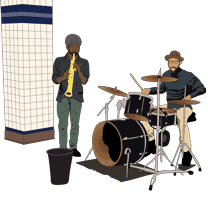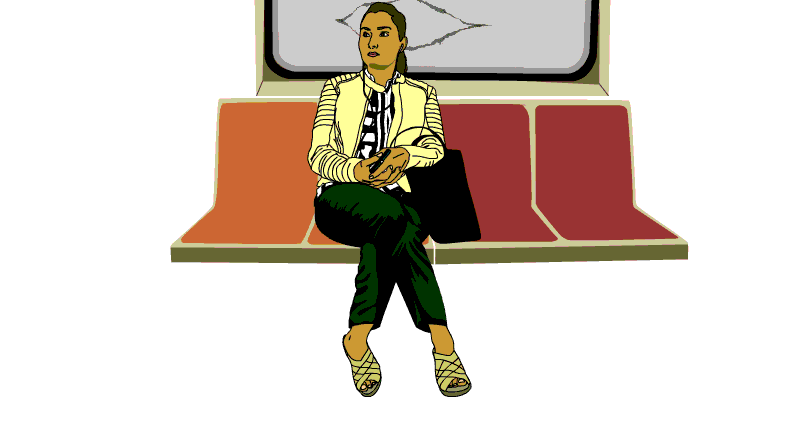Trump’s Disastrous Imprint upon Cuba
A recent article from El Pais details the mass migration of Cubans off the island:
Cuban economist and demographer Juan Carlos Albizu-Campos has announced that between 2022 and 2023, the island’s population fell by 18%… His study also references the 738,680 Cubans who arrived in the United States between October 2021 and April 2024 after receiving immigrant visas… The economy had been moving towards collapse since 2019, there were the economic sanctions of the Trump administration, economic and political measures that sank the country even further”
https://english.elpais.com/international/2024-07-23/from-a-population-of-11-million-to-little-more-than-85-million-the-real-toll-of-cubas-migratory-crisis.html
The first time that I was in Cuba in 2017, the island was in the midst of positive transformation. Tourism was thriving, there was construction throughout the streets of Havana and Camaguey. And the centers of both cities were bustling. Whether it was the curators of the video festival I participated in or the students working the festival or the owner of the home that hosted me, people appeared happy, friendly and eager for conversation and exchange. By my second visit, in 2019, the island seemed very transformed. Everyone I spoke with wanted off the island. Construction and renovation sites seemed abandoned. Tourism had radically declined. It was striking to see the negative change. I entirely blame Trump and his administration’s short-sighted isolationism.
As an extremely near neighbor of the United States, our empire has the power to quickly transform this island. Obama saw that possibility and even our responsibility to help the Cuban people. The Obama administration opened up travel to Cuba and Americans immediately embraced the island as a vacation destination for so many great reasons – quick and easy travel, inexpensive, and a taste of unique unAmericanized culture without McDonald’s or Starbucks on every corner. Everyone felt it was the moment to visit Cuba before McDonald’s, Starbucks, Target, Americanization took over… Trump’s moronic and selfish isolationism put a halt to the economic upswing of Cuba and rather than stopping the immigration of Cubans to the United States, his policies have brought the numbers up because hungry and desperate people will migrate.
Spring 2024 School of Practical Philosophy & Meditation Advertisement Campaign
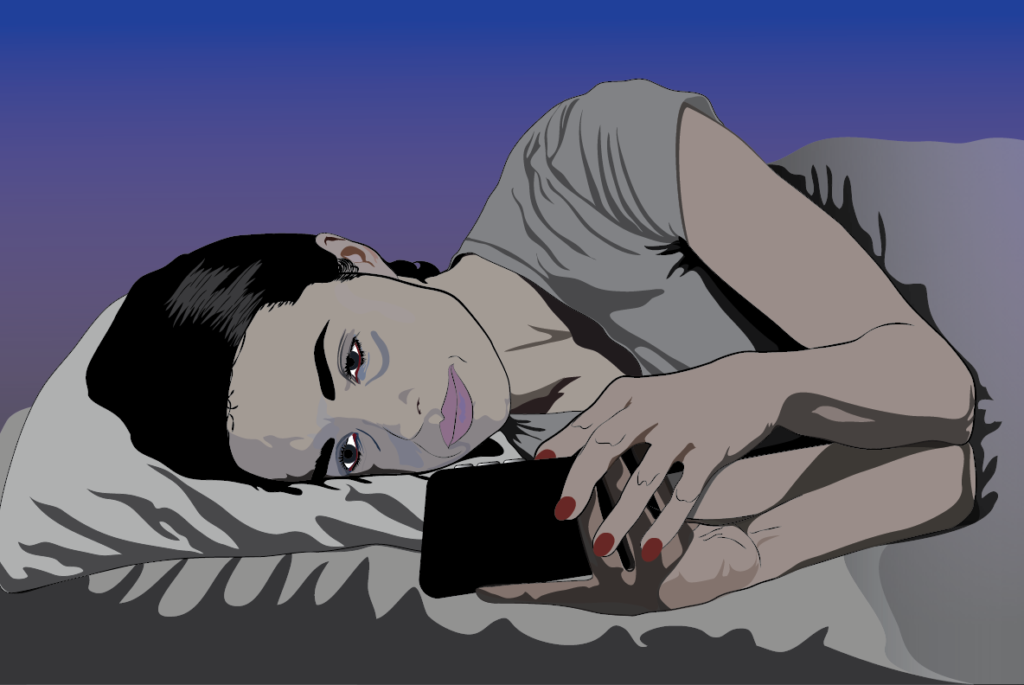
Jaime Rathore, the creative director for the advertising campaigns for The School for Practical Philosophy & Meditation once again hired me to create the MTA subway posters for the School. This time we worked with fellow School member and digital consultant Adam Wasserman to help generate ideas for the posters. Adam presented several ideas, the one that was selected features the word “TRANSCEND” trailed by a phrase that reflects common nagging realities (at least common to New Yorkers). A few of these phrases were:
- your late-night doomscrolling
- your roommate’s dirty dishes
- slow walkers
- your eight side hustles
The three that resounded best were: “TRANSCEND your late night doomscrolling,” “TRANSCEND your side hustles” and “TRANSCEND your roommate’s dirty dishes.” As both the budget and time were tight, I was asked to reuse some of the recent artwork. I did, however, create a new illustration for the doomscrolling concept (pictured above) as I didn’t have an appropriate asset. Below are the two in-car subway posters that will be presented above riders’ heads and one platform poster. Adam suggested editing the illustrated characters’ t-shirts from showing the entire School logo and name to only showing the logo (which I think works nicely).


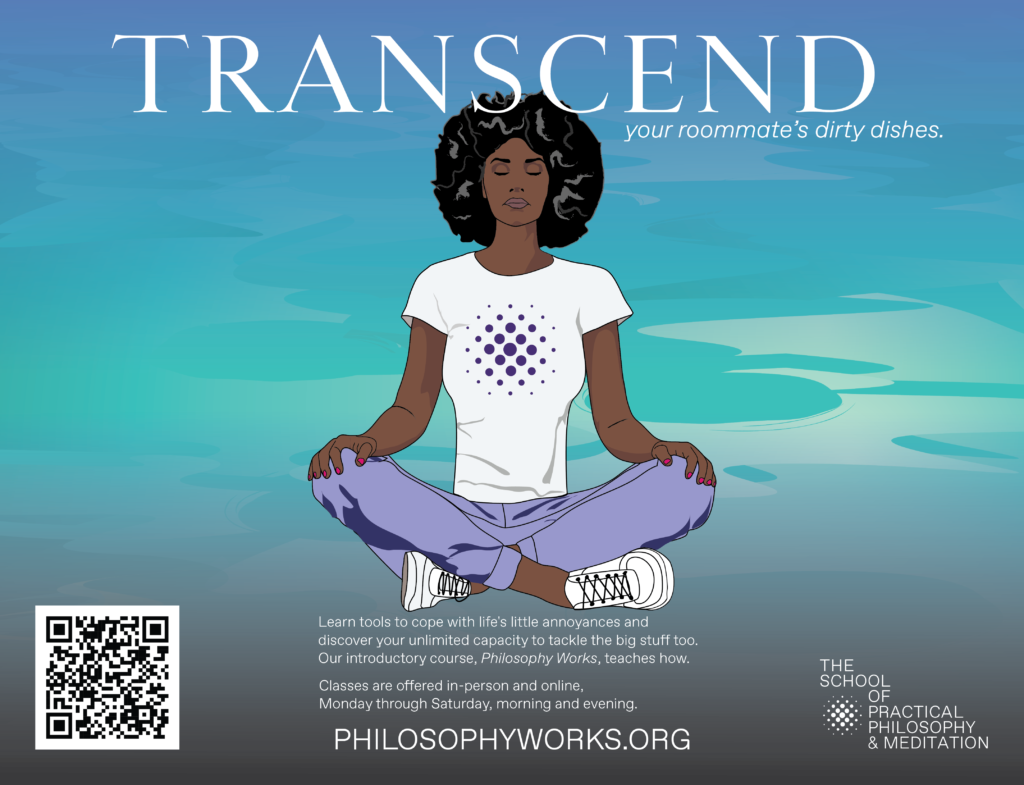
Winter Ad Campaign for the School of Practical Philosophy & Meditation
The winter MTA subway campaign’s in-car poster remained consistent with the fall design. However, the characters were given winter coats, beanies, the LGBTQ revelers became New Year 2024 revelers. The two men arguing along the bottom left were given NY sports team colored beanies. The mom and daughter to the right are making a snowman instead of tending to a garden. The bike deliver person has been given a winter coat, gloves, helmet and food delivery backpack. If one zooms into the helmet, it is decorated by WAK – WAK is the pronunciation for the Mayan hieroglyphic representing the number six. Places labeled six are cosmic realms in Mayan writing. As an ear decoration, this rendition of WAK wears a smart phone.

For the subway platforms, the creative director, Jaime Sears requested a new design. She envisioned a woman against skyscrapers, at ease as if meditating amidst the magnitude and intensity of New York City. Following her concept, I created a series of glass towers from the street perspective and placed a young woman with her eyes closed at the center, the towers rising all around her.
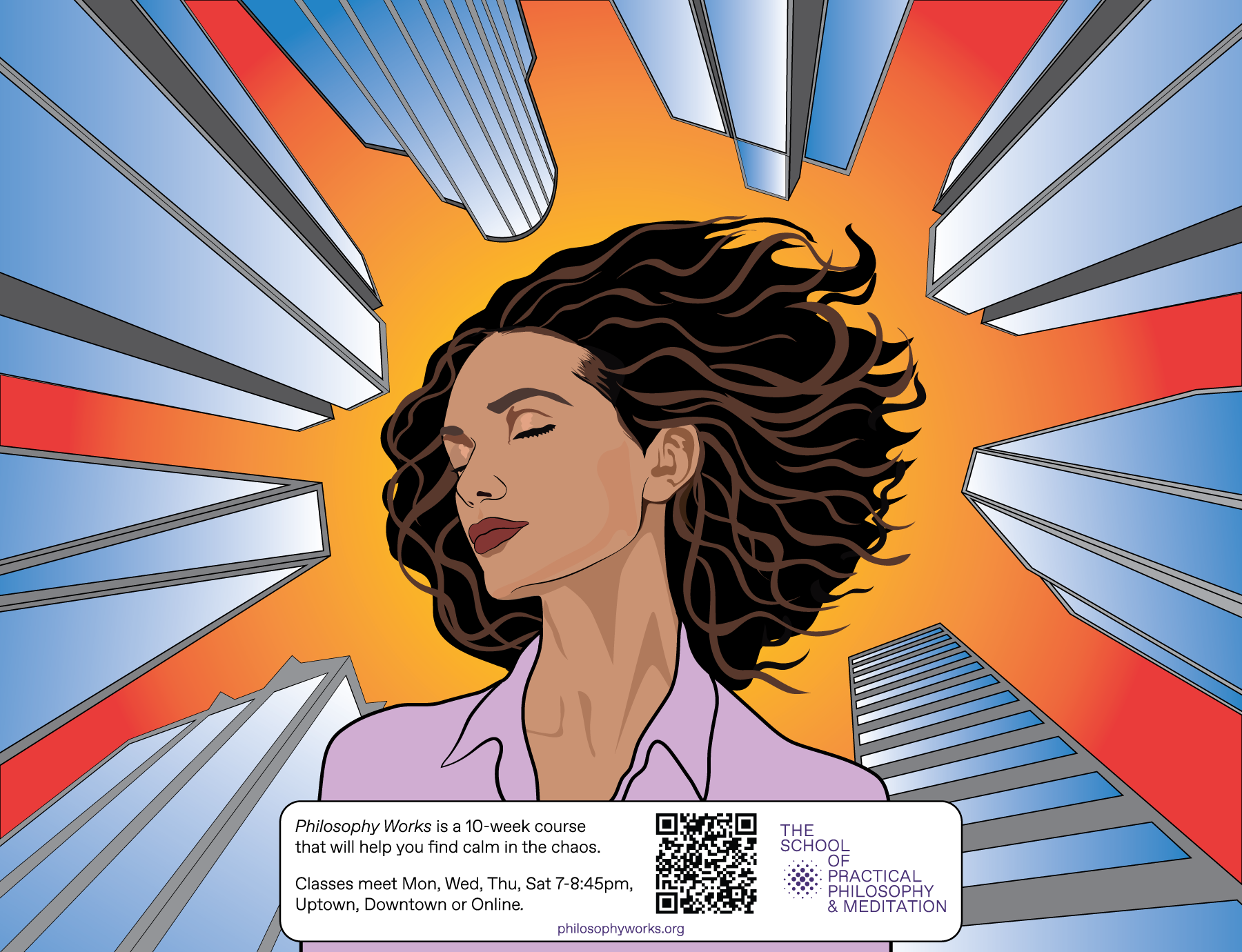
Lastly, I was asked to create a design for the Wallkill postcard. The budget was small and I was asked to work with existing assets, so I created a new setting and recycled the NYC characters. Linda Engler, a longtime member of the School who lives near the Hamlet of Wallkill where the School has an estate took photographs of New Paltz Main Street. Linda took the photographs to provide me with source material for the postcard. I used a photograph of the Indigo Velvet and Rock Candy Vintage building to help illustrate a New York town setting. I maintained the concept of an individual in meditation as the central element while other characters go about their lives. Hopefully, the postcard will visually engage viewers and draw them into learning about the School of Practical Philosophy and Meditation.
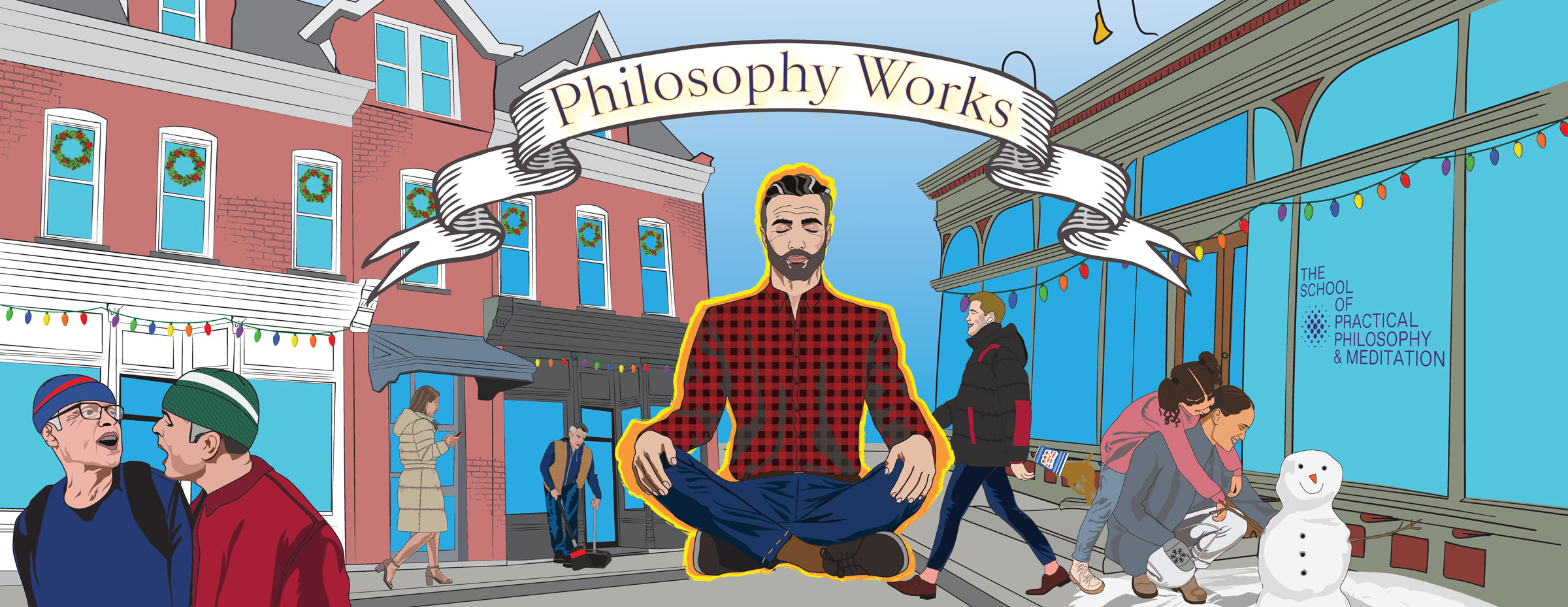
Latest Podcast Story

Nearly a year ago in January 2023, I encountered a series of after-school activities on my commute home from the Upper East Side to Brooklyn. During my commute, I regularly check my brokerage app. I collapsed that commute’s observations into a very short story titled “They Took All My Money in One Day” and then posted the story on this blog. As I maintain a podcast of short stories, really Science Fiction short stories, I decided to add my own story to the podcast, although it’s not Science Fiction. The story is however dystopian, a current-day dystopian reality… It’s only four minute listen:
https://www.ambriente.com/immersiveWorlds/
https://www.ambriente.com/immersiveWorlds/index.xml
Apple Podcast link: https://podcasts.apple.com/us/podcast/immersive-worlds/id1707925334
Immersive Worlds Podcast
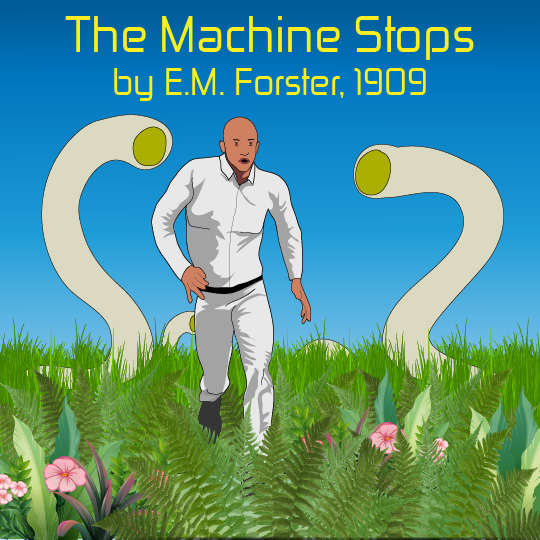
I have been a “New Media” professor since 1999 and while teaching technical production courses, I have learned that it can be inspirational for the student to interweave fiction into these courses. The short stories that I select relate directly to the technical material, such as web development. For example, a story such as E.M. Forster’s 1909 “The Machine Stops” is both inspirational and illuminating. Most students do not consider how a 1909 fiction may reflect contemporary life. Over the years, I have developed a list of such readings and I have decided to read, record and publish these readings. Although I am not a voice actor, I hope someone might enjoy these readings. (I am also enjoying creating the illustrations for these readings.)
The recordings are available via the browser and as a Podcast:
https://www.ambriente.com/immersiveWorlds/
https://www.ambriente.com/immersiveWorlds/index.xml
Apple Podcast link: https://podcasts.apple.com/us/podcast/immersive-worlds/id1707925334
There are currently two stories available:
“The Machine Stops” by E. M. Forster published in November 1909 issue of The Oxford and Cambridge Review. Perhaps due to radio and an expanding telephone system and inventions such as the Nipkow disk and mechanical televsions Forster was able to envision people communicating via hand-held discs. But even with these 19th century inventions, Forster’s world in which people live in isolation and communicate via a live image seems incredibly prescient. Due to apocalyptic wars, humanity retreated into the earth and constructed a gigantic machine to tend to all their needs. After hundreds of years, the Machine is a god-like construction, until it begins to break down.
“With Folded Hands” by Jack Williamson published in the July 1947 issue of Astounding Science Fiction. Following World War II and the atomic bombings of Hiroshima and Nagasaki, Williamson felt that “some of the technological creations we had developed with the best intentions might have disastrous consequences in the long run.” Today, with the rising use of artificial intelligence, Williamson’s short story seems as relevant as when it was first published in 1947.
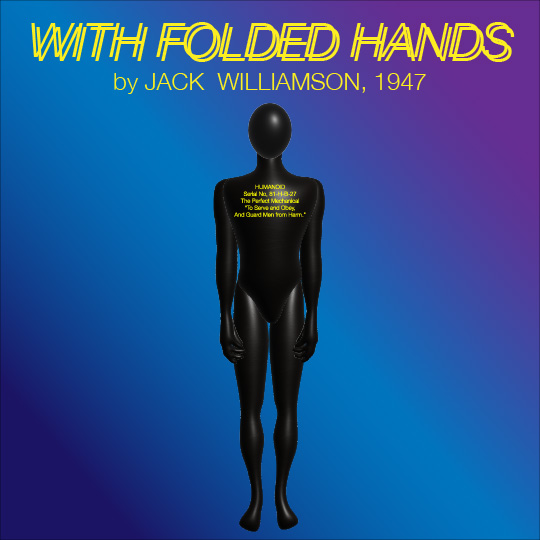
Philosophy Works 2023-24 Ad Campaign

“The School of Practical Philosophy & Meditation offers a journey of self-discovery that guides students toward understanding their innate wisdom and appreciation of the underlying unity connecting us all. Philosophy Works, the introductory ten-week course, prepares students for mantra-based meditation, an offering upon completion.”
THE CHALLENGE
In-person enrollment has been dropping for the last two years. The brand identity has gone through many iterations. We need a campaign that will once again establish the School as the NY community hub for Practical Philosophy.
THE GOAL
To reach our audience more efficiently, speak to their pain point and engage them with the benefits of PHILOSOPHY WORKS. We expect to increase our in-person Philosophy Works classes on the Upper East Side and Tribeca.
MY DESIGN APPROACH
When on the subway, I seek out the illustrations commissioned by the MTA and I tend to lose myself in the stories that the illustrators create. I do not seek out advertisements. (Of course, I don’t need to as they can’t be missed.) Generally, the advertisements are not engaging. My approach to this project is to be a visual artist and storyteller, not an advertiser. My goal is to create an in-car advertisement that people may lose themselves in through illustrated New Yorkers and the possible interactions and activities of these characters. The School’s Creative Director, Jaime Sears felt that the advertisement needed to speak to the difficulties and uncertainties (“pain point”) commonly experienced by New Yorkers at this time. Ideally, the scenarios in the illustration will be familiar to most New Yorkers.
With these concepts in mind, I rode the subway and traversed the city. I photographed fellow commuters and eavesdropped on their conversations, observed their interactions. Specific individuals and life moments are represented in the final illustration. The majority of the characters in the final composition are real New Yorkers – commuters, pedestrians, recyclers, and even our infamous subway rats…
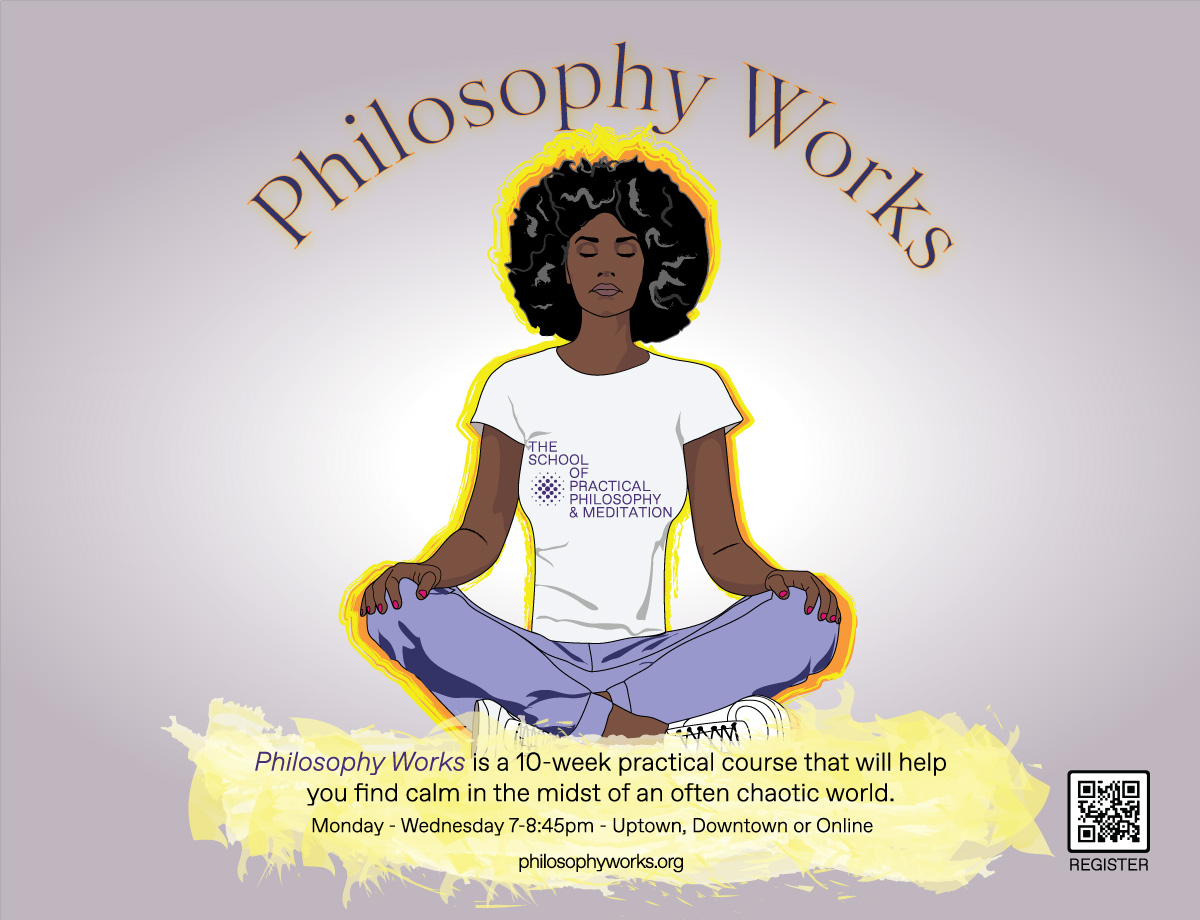
THE CAMPAIGN
As meditation is a key element of the School and a practice known to calm people, I elected to have meditation be the central element to the design. Without the funds for a photo shoot, I searched online for people meditating. I found an attractive young woman sitting on the floor with her hands’ index finger and thumb touching. At the School, people generally meditate in a chair, however, design-wise, I felt that the chair would take up too much horizontal space, so I purchased the rights to the photo of the woman on the floor in a criss-cross applesauce pose and changed the hand pose. I based the central illustration on this photograph. I also wanted to make the name of the School central, so I placed the School’s name on her t-shirt at the very center of the design.
I surrounded the meditating woman with vignettes of everyday life from subway to street. Moving from left to right: subway musicians, a Hasidic commuter studying, a young woman with her earbuds in place, a businesswoman busily texting, two men in conflict, an MTA maintenance worker sweeping as he watches a business dandy toss his coffee cup on the platform floor with a trash can nearby… At the center, a woman meditating with a fiery aura outlining her figure. Then to the street (right side of the design) – a young female pedestrain wearing a surgical mask, PRIDE revelers enjoying life, an older man observing the street scene from his window, a mother and daughter gardening, a food delivery guy on his bike, and people recycling. A few of these illustrations, I had already created for past projects. The subway musicians and female subway rider I rotoscoped long ago for a series of animations reflecting New York City life. The rat and delivery guy are from a 2D video game and installation, una geografia de ser. Recycling past illustrations was necessary as the turn around on this project was very tight. However, the rest of the work is new.
I created a version of the graphic illustration with thought bubbles or spoken text for the various characters, but the School preferred that viewers interpret the illustration for themselves. Throughout the illustrations, I attempted to represent points of conflict that are common to the density of New York City.

The platform poster is much simpler and hopefully striking. It merely presents a woman meditating. Since people are on the platform for a shorter span of time, waiting to get on a train or exiting the station, I wanted to create a graphic that would immediately speak to the commuter.
Here are images posted in the subway cars and in the platforms:
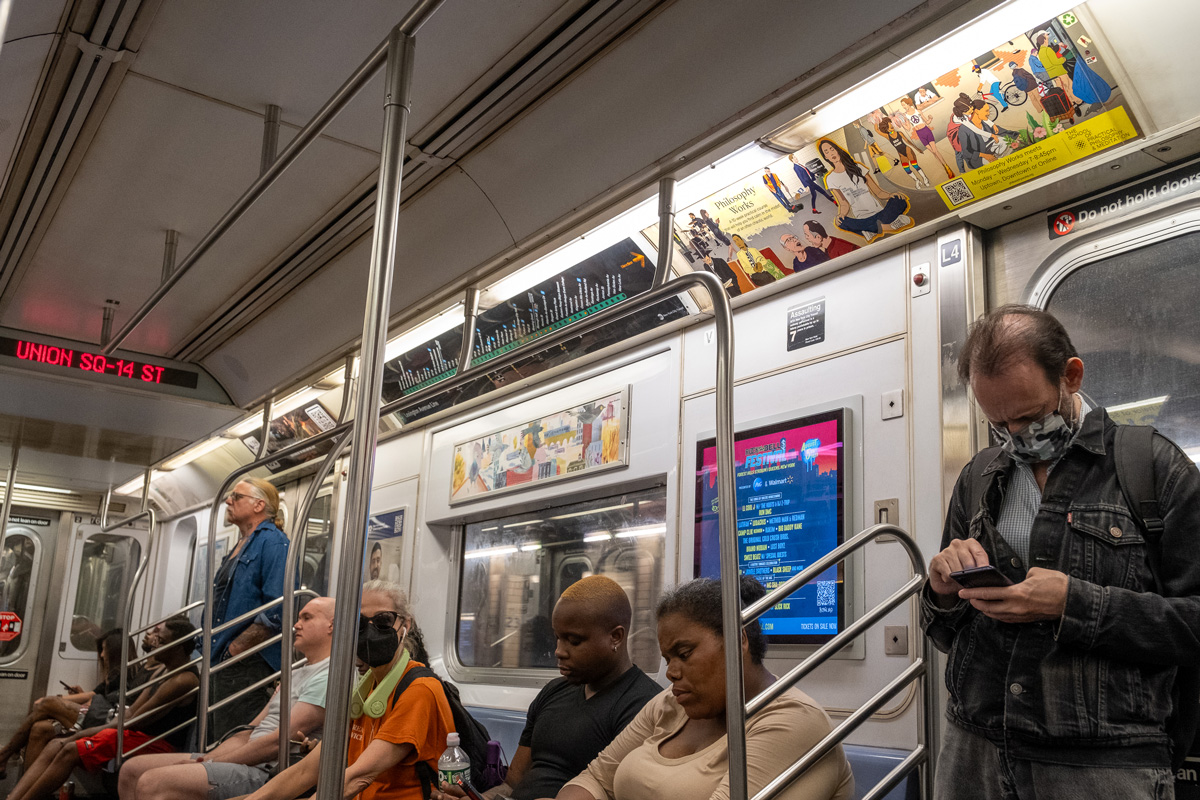
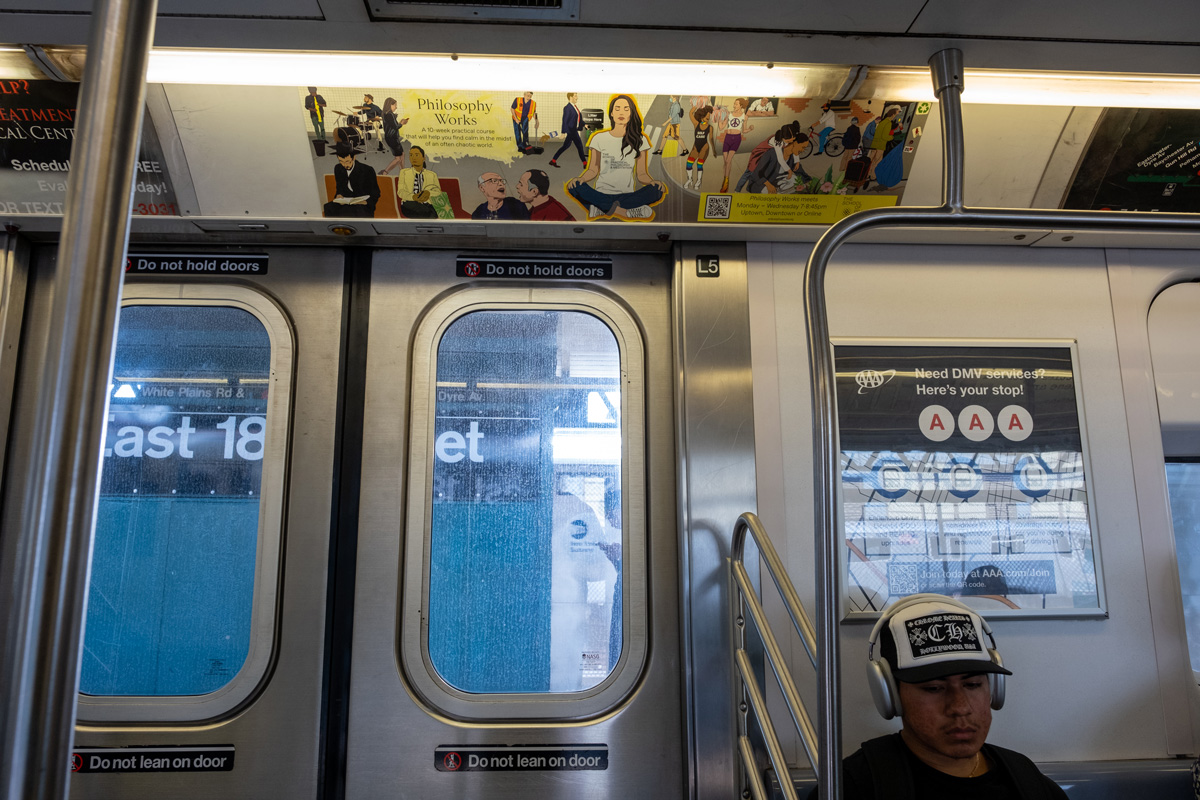
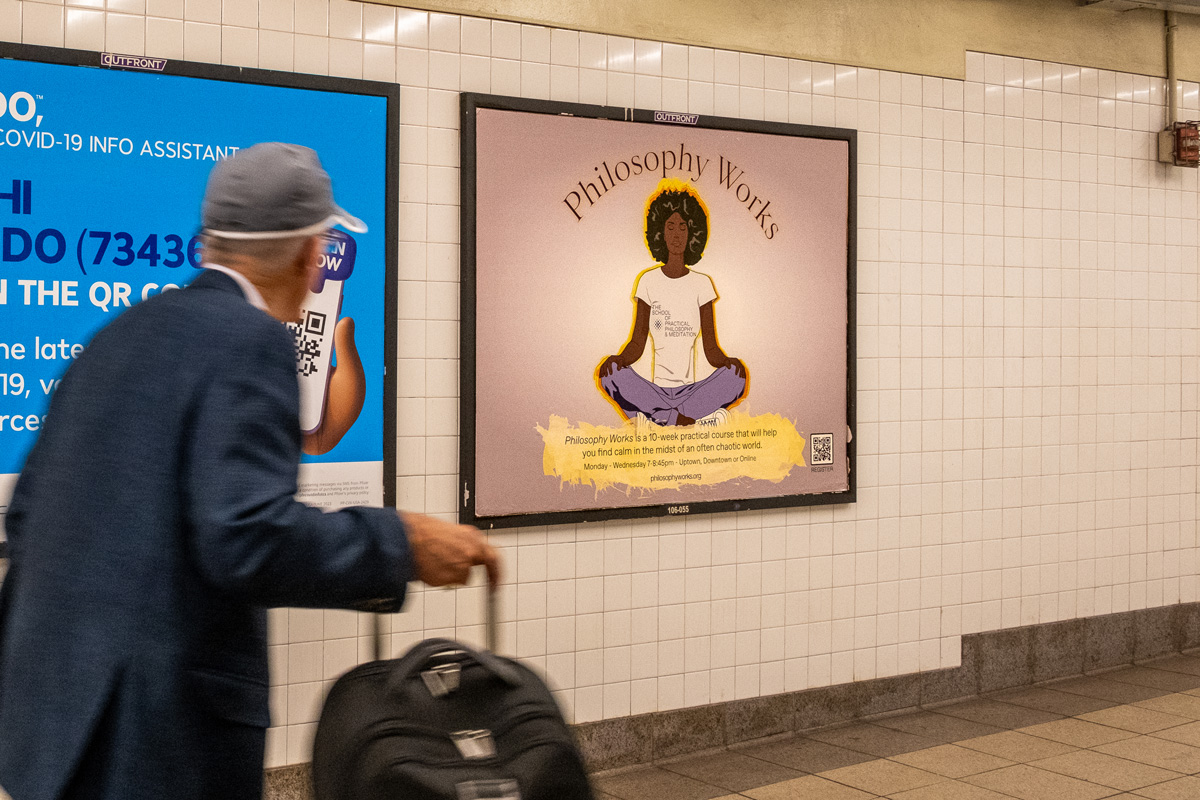
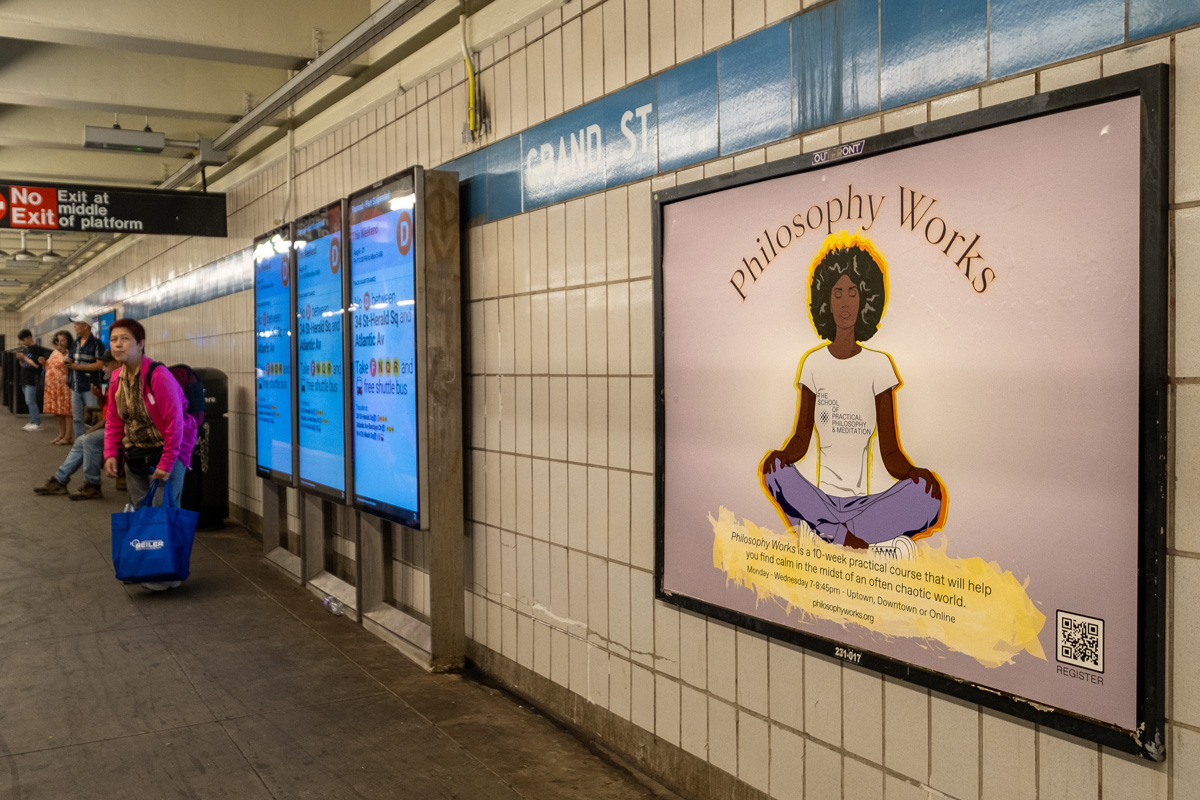
They Took All My Money in One Day
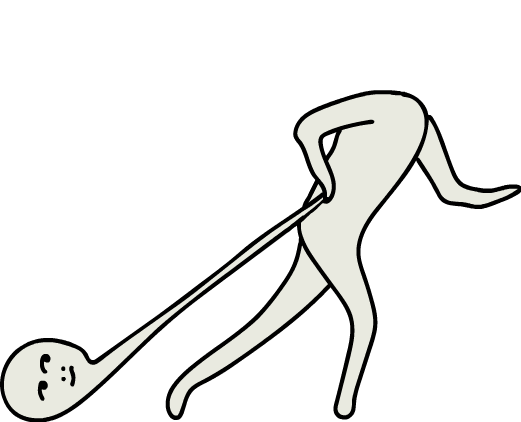
Walking along the 86th Street and 2nd Avenue Q platform, I heard screams of agony from a young voice. Between loud crying and guttural sounds, I distinguished the phrase, “They took all my money in one day.” The words repeated over and over as inconsolable screams with pauses only to breathe while crying.
I couldn’t see who the boy was, but as I quickened my pace out of curiosity and to reach the far end of the platform before the southbound Q arrived, the cries got louder and louder. Finally, I was in eyesight of the tortured creature; a boy who looked about six wearing a blue blazer, white shirt, and khaki trousers, light brown hair neatly parted to one side. The boy was accompanied by his father, an older middle-aged man, athletic in appearance.
The father kept his left hand on the boy, rubbing his back and gently squeezing the shoulder. His right hand held a briefcase. He was speaking softly trying to console the boy, but the boy did not appear to hear a word that the man said as the crying and screaming – “They took all my money in one day…” did not stop. The boy’s chest was heaving, large tears falling down his cheeks. In the short time that I could see them, I observed the boy’s face redden. Myself a father, I was intrigued. Had the boy been bullied by schoolmates who took his money?
I put aside my goal to make it to the far end of the train and board the last car, which at the Brooklyn Church Street stop leaves me right by the stairs leading toward my home. I was now hoping the train due in two minutes would be delayed so that I could learn about this boy’s lament.
The father and boy had slowly made their way to a steel bench at the center of the platform. The father sat down to be at eye level with the boy. They had their backs to the southbound side of the platform that I had been walking along. So I walked toward them, considering taking a seat on the same bench, but really just trying to get close enough to hear the father and get a sense of what had happened to this poor boy.
It was 3:30 in the afternoon and on my way to the subway, I had walked past similarly uniformed boys of various ages. Certainly, this boy attended an Upper East Side private school – The Buckley School or Saint David’s maybe Dalton? Perhaps his money was spent by the twelve or thirteen-year-olds buying pizza on Lexington. This was a group of unruly boys in the same uniform. I had to brush against the blue-blazer’d mob as they monopolized the width of the sidewalk just outside of Famous Famiglia at 84th and Lex. I could easily imagine those older kids taking money from a six-year-old just for laughs.
I now heard the father repeating to the boy, “This is just part of the game, it’s how it works…” as he held the boy’s arm. I was now discreetly watching. I observed the boy reach into his pocket, his chest still heaving, tears still streaming down his face, but he had stopped repeating the phrase. The boy pulled out an iPhone, cupped it in his small hands, and with a couple quick thumb swipes opened a trading app. The app in dark mode presented red, negative numbers, and a plummeting sparkline. The boy stared down at his phone as the screen blurred with tears.
Reading: The Making of the Indebted Man (note 4)
From The Making of the Indebted Man by Maurizio Lazzarato. The following are all quotes from the book:
The Subprime Crisis
No direct or indirect wage hikes (pensions); instead, consumer credit and the push for stock market investment (pension funds, private insurance). No right to housing; instead, real estate loans. No right to tuition; instead, university loans. No risk mutualization (unemployment, health, retirement, etc.); instead investment in private insurance.
The wage-earner and the beneficiary of public programs must earn and spend as little as possible in order to reduce labor costs and the costs of public services, whereas the consumer must spend as much as possible in order to use up production. But in modern-day capitalism, the worker, the beneficiary, and the consumer are all one and the same.
Pg. 110
Christian Marazzi argues, we have moved from public deficit spending to private deficit spending in order to prop up the global demand for goods and services.
Pg. 112
The Sovereign Debt Crisis
Banks were saved through the use of the “public” money to nationalize their losses. The State injected a money flow into society – which is, as Deleuze has shown us, a flow of power – in order to reestablish and reinforce the power relation between creditors and debtors.
Pg. 115
Society is not the space in which a certain distance or a certain autonomy is created with respect to the State; rather, it is the correlate of governmental techniques. Society is not a primary and immediate reality but part of the modern technology of government, its product.
Pg. 125
Reestablishing the “relation of man to man” spoken of by Marx, reveals itself instead as the source and height of the cynicism and hypocrisy of our “financialized” society. Continuous cynicism and hypocrisy not only in relations between bankers and costumers, but also in relations between the State and the users of social services.
Pg. 136
Debt operates not only in the manipulation of enormous quantities of money, in sophisticated financial and monetary policies; it informs and configures techniques for the control and production of users’ existence, without which the economy would not have a hold on subjectivity.
Pg. 137
Etymologically, autonomy means to make one’s own law. At the unemployment and welfare agencies, employment, competition, and the market are the law. Autonomy means being able to find one’s own bearings. At the unemployment office, everything always points to employment, the market, and competition.
Becoming “human capital” and being an entrepreneur of the self are the new standards of employability.
Pg. 145
Reading: The Making of the Indebted Man (note 3)
From Chapter 3 “The Ascendency of Debt in Neoliberalism,” The Making of the Indebted Man by Maurizio Lazzarato
The increase in psychologists’, sociologists’, and other ‘self-help’ experts’ interventions, the creation of ‘coaching’ for better-off workers and obligatory individual monitoring for the poor and unemployed, the explosion of ‘care of the self’ techniques in society – these are symptoms of the new forms of individual government, which include, above all, the shaping of subjectivity.
Pg. 95
Biopolitical Power
A massive transfer of revenue to business and the wealthiest and an expansion of deficits due to fiscal policies, deficits which have in turn become a source of revenuer creditors being State debt. The ‘virtuous circle’ of the debt economy is thus complete.
Pg. 103
Unlike what happens on financial markets, the beneficiary as ‘debtor’ is not expected to reimburse in actual money but rather in conduct, attitudes, ways of behaving, plans, subjective commitments, the time devoted to finding a job, the time used for conforming oneself to the criteria dictated to finding a job, the time used for conforming oneself to the criteria dictated by the market and business, etc. Debt directly entails life discipline and a way of life that requires ‘work on the self,’ a permanent negotiation with oneself, a specific form of the subjectivity: that of the indebted man.
Pg. 104
Power relations that crystallized around May ’68 has led to the creation of a power bloc acting – often by trial and error – on different mechanisms of power at the same time (at times favoring the market, at other business or the State).
Pg. 106
Governmentally has produced a collective capitalist – as Lenin would put it – which is not concentrated in finance, but operates throughout business, administration, service industries, political parties, the media, and the university. This political subjectivation provides capitalists with the same education, the same vision of the economy and society, the same vocabulary, the same methods, in short, the same politics.
Pg. 108
VR: It May Be Difficult to Monetize Isolation
In 1909, E.M. Forster wrote a short story titled “The Machine Stops” that is set in a post-apocalyptic Earth in which humanity exists underground in a network of tubes. Each individual lives alone in a small hexagonal room and social interaction is through a screen. The majority of the population worships the Machine that they live in and fear the outside world. Over a 100 years later, E.M. Forster’s short story appeared incredibly prescient during the height of the pandemic, however, even before the pandemic, as people stare at their screens, the short story has reflected elements of current day life. Throughout the very short history of advertisement, our eyes and attention have been the commodity. Today as virtual reality (VR) and augmented reality (AR) attempt to gain a foothold as major media platforms, our eyes focus upon small screens. The films we once watched on giant movie screens with state of the art sound systems are now consumed during a commute on a handheld screen and headphones. The smart phone and every related technology has been transformative from production to consumption. However, when we click on a mobile digital ad, it remains largely accidental. A quick “damn it” and click on an X closes the ad and returns us to our happy stream. In order for VR and AR platforms to gain a foothold in society, they must be financially viable which means that the ad streams must be commercially relevant and not a mistaken pupil glance or blink. Have we been prepared to live in the machine or do we already exist in the machine and merely need to incorporate the screens as a headset? It may very well be that many people would opt to wear their smartphones rather than have to hold them.
Meta, the corporation once known as Facebook that owns WhatsApp, Oculus, Instagram and is the greatest promoter of the so called metaverse, lost half a trillion dollars on October 27th 2022. Mark Zuckerberg, CEO of Meta, has declared that the metaverse is a long term endeavor and that IT IS the future. In 2021, Apple handed over to the user whether or not one’s data is tracked for advertising and with the loss of the iOS tracking data, the value of targeted advertising has plummeted. Over the last few quarters, Alphabet (the parent company of Google) has had a 5% decrease in advertising pricing, however, Meta’s decrease has been an 18% price loss per advertisement. The loss of ad revenue is reflected in a drop of Alphabet and Meta’s stock value, however, again the Meta stock value has plummeted in comparison to Alphabet. This may be a short term falter or it may reflect that these companies do not have a lasting value.
Over the last six years I have been critical of virtual reality, however as a “new media artist” I have been curious and open to new creative platforms and I have been developing projects that are exported for both the desktop and virtual reality. Today, I remain highly skeptical of placing a device a couple inches from one’s eyes with a split screen for stereoscopic imaging to create an “immersive experience.” I feel that it is unhealthy and ridiculous. During the week of October 20th, I participated in DIGITAL ART ZURICH, a festival featuring several virtual reality (VR) projects. I witnessed one person come away from an interesting VR project feeling sick, unable to focus and state that if that is the future, they want no part of it. Later that day, this same person told me that it was at least two hours before they felt clear minded and well. I experienced the same VR project that was seated and had me dollying through a sci-fi narrative. In this project, teleporting and physically moving about was not available. I was fine through the experience, however, by the end I was sweating, the headset had become hot, heavy and uncomfortable and I badly wanted it off my head. The project lasted 10 to 15 minutes.
In a different gallery, there was a standing VR project that did not dolly the user through virtual environments and the only movement was to look around. This project was less uncomfortable. The greater issue here is that each user is isolated in their headset and the project itself seemed disorganized or without a central and coherent point. In the same gallery, there were desktop projects presented on large screens with keyboard and mouse interaction. With these projects, I saw friends sitting together, playing and discussing the projects.
A few weeks ago, I brought home an Oculus Quest 2, produced by Meta. My 14 year old son begged that I purchase an NFL VR game. I did so and then for 20 minutes, he was isolated in the headset throwing touchdowns. Previously, we would watch or play games together. Meta CEO Zuckerberg states that the metaverse will be social. Meta has launched Meta Quest Pro, a virtual and mixed reality headset. I have tried Microsoft’s mixed reality HoloLens and view it as a far superior experience to virtual reality, because I can see and interact with the real world environment while also seeing a virtual overlay. I do believe that mixed reality has a future if our eyes and minds can adapt to it. I do not feel the same about virtual reality.
I am an associate professor in the Department of Film & Media Studies at Hunter College. I teach an introductory digital production course that is split between a lecture and laboratories. The lectures present histories and theories regarding visual communication, graphic design, photography, animation, game production and non-linear storytelling. During the pandemic, the lectures and labs went online. This school year, the labs have returned to in-person, however the evening lecture has remained online. Attendance to the lecture has plummeted, perhaps it is my presentation or the fact that I record the lectures and provide my slides and notes, but I think the underlying issue is that it’s online. I regularly receive emails about free online lectures and if the topic is of interest, I sign up. However, of every ten lectures that I sign up for, I may attend one and many times I do not stay through to the end. Online lectures, virtual reality, distance learning, do not carry the commitment and strength of in-person interaction and experience. It’s difficult to blame the student.
Meta may be able to suffer ongoing financial losses. And Meta may find a way to resuscitate Facebook or monetize WhatsApp or Instagram or turn Oculus into an advertising platform; the bottom line is that technologies for mass adoption require immense funding. Over the last six decades, VR experiments have been promoted as the future of entertainment or gaming only to fail. I firmly believe that a mass audience does not want to wear a headset to be isolated with a screen a couple inches from their eyes. In my experience, even the social VR platforms through avatar interaction are isolating and dystopian. Perhaps the mixed-reality Meta Quest Pro will be a success and this is the moment to invest in Meta as the stock has fallen to a 2015 price. As mixed-reality headsets use eye tracking for navigation, it may very well be hard for users to not accidentally click on virtual ads an inch from their pupil and Meta’s price per ad will skyrocket.
